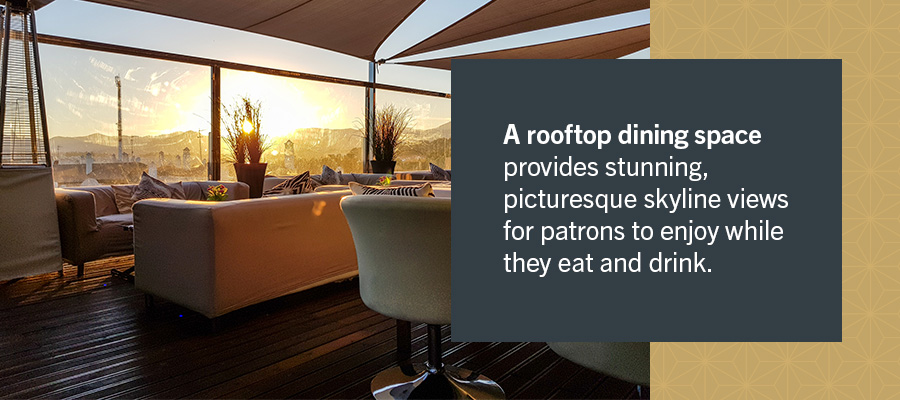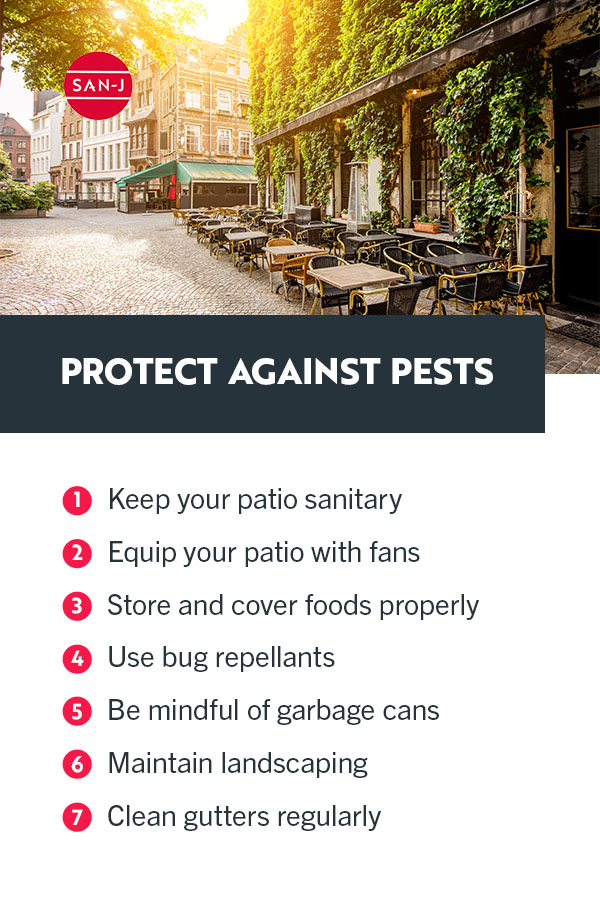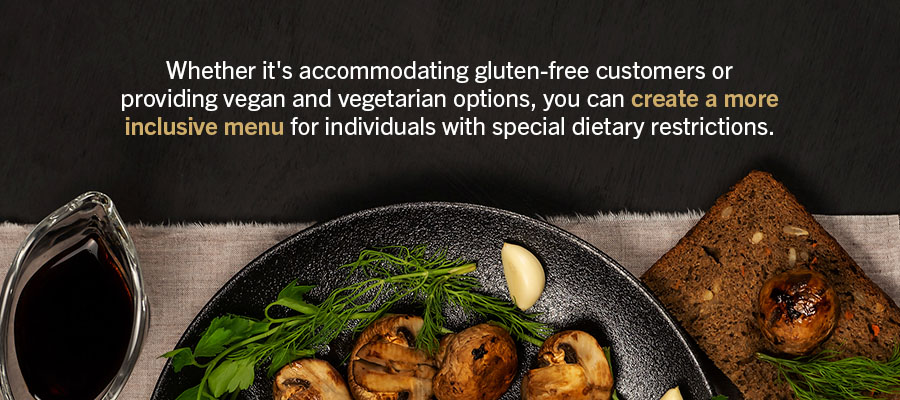How can restaurants be more appealing? If you’re searching for the best tactics to improve your business’s dining experience or drive up profits, you may be asking yourself this question. Offering outdoor dining is an excellent way to improve customer dining experiences, incorporate elegant outdoor design features and more.
From preparing for pests and bad weather to choosing the right patio furniture, you must consider a few points when creating an outdoor dining space for guests. Browse our complete guide of outdoor restaurant ideas for tips on boosting your business’s outdoor dining experience!
Table of Contents
What Defines Outdoor Dining?
1. Take Advantage of Your Space
2. Check Rules and Regulations
3. Carefully Plan Your Layout
4. Prepare for Bad Weather
5. Protect Against Pests
6. Choose the Right Furniture for Your Space
7. Add Outdoor Cooking Equipment
8. Match Your Brand
9. Edit Your Menu
10. Create an Efficient Workflow
11. Offer Adequate Shade
Elevate Your Restaurant’s Dishes With San-J
What Defines Outdoor Dining?
Simply put, outdoor dining — also called “al fresco dining” or “dining al fresco” — is eating outside. This type of dining is particularly common during warmer months when weather and temperatures are more favorable.
While outdoor dining is often characterized by a casual atmosphere, many upscale restaurants also have trendy outdoor extensions of their restaurants. In many cases, it also includes additional activities to entertain guests, such as drinking and enjoying live music or other performances or sitting by a fire pit.
The main benefit of outdoor dining is that it allows for extra seating and space, which allows you to serve more customers and bring in more revenue. If you’re thinking of sprucing up your restaurant with outdoor dining, read on for some handy tips and ideas to make the best use of your space!
1. Take Advantage of Your Space
There are multiple ways to integrate outdoor dining with your existing space. Below are three different methods to consider:
Patios
Whether your building already has a built-in patio or the space to install one, consider boosting your restaurant’s outdoor dining experience by revamping your current patio or creating one from scratch. If you’re looking for ways to improve your restaurant patio, we have plenty of ideas to help you out below.
Sidewalk Seating
If your restaurant is on a highly-trafficked street or part of an outdoor mall, know that you don’t need a large amount of square footage to spruce up your outdoor dining space. Offering sidewalk seating at the front of your restaurant could be an excellent way to attract passersby. With a few umbrella-topped tables, comfy seats and some elegant outdoor decor, you can create a Paris-esque dining experience for your customers.
Rooftops
A rooftop dining space provides stunning, picturesque skyline views for patrons to enjoy while they eat and drink. This option creates an unforgettable experience for guests that will surely encourage them to return. If you can reasonably transform your restaurant’s roof into the ultimate outdoor dining space, we highly recommend giving it a try.

2. Check Rules and Regulations
Keep in mind that every state, city and county will have certain regulations in place when it comes to outdoor dining. These may relate to:
- Permits for outdoor plumbing and electricity
- Smoking laws
- Outdoor seating requirements
- Pet guidelines
- Noise ordinances
- Serving alcohol and BYOB services
Before designing your outdoor patio, it’s important to brush up on your area’s rules so you can operate safely and legally. Because guidelines and permits can vary by location, be sure to get in touch with your municipality to figure out what steps you should take before you open up your outdoor dining space.
3. Carefully Plan Your Layout
Before purchasing new furniture and equipment, carefully evaluate your space to determine your restaurant’s outdoor seating design. Decide how you’d like to utilize the area — will it simply provide additional seating and dining space or include other creative features?
While the former is certainly an easier option, providing some extra perks and activities for customers to enjoy can be an excellent way to bring them back time and again — not to mention build buzz around your restaurant and attract new customers.
Here are some things you might consider factoring into your patio layout:
- A comfy lounging area with couches and a fire pit
- A performance space for live music and entertainment
- Outdoor televisions
- A beer garden
- A rooftop bar
- A pet-friendly dining area
Think of specific features you can add to create a fun, memorable experience for your guests. From there, you can figure out if and how your space can accommodate them.
4. Prepare for Bad Weather
Regardless of your restaurant’s location or the time of year, you’ll always want to prepare for inclement weather. Below are a few weather conditions to plan for:
- Precipitation: Enclose your patio with a large tent, shade structure or roof. After a rainstorm, be sure to wipe down chairs and tables.
- Chilly temperatures: Because temperatures can start to drop in the evenings, it’s a good idea to equip your outdoor patio with heaters or a fireplace.
- Heat: Install ceiling fans or air conditioners to improve airflow and keep your guests cool on hot days.
- Sunlight: Provide ample shade for guests by setting up deck covers and umbrellas.
If your restaurant doesn’t already have an evacuation plan for extreme weather, now would be a good time to create one.

5. Protect Against Pests
When offering outdoor seating, it’s crucial to protect your patio from bugs, rodents, birds and any other pests that could potentially invade your space — particularly during the warmer months when critters are most present.
To protect your patio against pests, here are some important tips to keep in mind:
- Keep your patio sanitary. Because bugs and rodents are drawn to crumbs, spilled foods and beverages, applying proper restaurant sanitation practices is a helpful way to keep pests under control. Quickly clear away uneaten food and sanitize tables, counters, cooking equipment and other surfaces. Additionally, remember to sweep, vacuum or mop the floors at the end of each day.
- Equip your patio with fans. This airflow can help divert insects from food and customers.
- Store and cover foods properly. Remember not to leave any containers of food out in the open. Particularly, bugs are drawn to sweets and sugars, so it’s important to keep fresh fruits and juices covered in secure containers. If you have an outdoor bar with mixers and garnishes, this is especially critical to keep in mind.
- Use bug repellants. Another pest control method is equipping your patio with sprays or bug zappers. Try more natural light-based repellents like citronella candles or tiki torches, too.
- Be mindful of garbage cans. Since pests are drawn to garbage, you may want to avoid placing trash receptacles outdoors. If you do have garbage cans outside, be sure to cover, clean and empty them consistently.
- Maintain landscaping. Be sure to mow any surrounding grass and trim shrubbery and tree branches regularly. If you don’t consistently maintain your restaurant’s landscaping, your outdoor space can become more susceptible to critters.
- Clean gutters regularly. Be mindful of any exposed standing water that could potentially attract mosquitoes or other pests. This includes cleaning gutters and maintaining any ponds, fountains or other water features.
6. Choose the Right Furniture for Your Space
Choosing the right patio furniture is important for creating your desired theme and atmosphere. For example, maybe you’d like to capture a rustic style with wooden benches and tables. On the other hand, perhaps a more modern ambiance with metal chairs or neutral-colored seat cushions would better suit your preferences. No matter the concept you have in mind, try to pick the appropriate furniture to decorate your space.
When planning your restaurant’s outdoor seating design, you should consider table shape, tabletop material and the type of seating. This furniture should both highlight the theme of your restaurant and incorporate a comfortable, durable structure. Be sure to research quality and cost-effective materials to determine the right type for your furniture.
7. Add Outdoor Cooking Equipment
If your space allows for it, consider adding some outdoor cooking equipment such as a smokehouse, stove, pizza oven or grill to your patio. By cooking food outside, guests can see a glimpse of the process your chefs take to create their dishes. Additionally, the enticing aroma of food sizzling on the grill is a great way to attract passing customers in highly-trafficked areas.
8. Match Your Brand
Like with any business, creating and maintaining a cohesive brand for your restaurant is essential. Whether you’re sticking to your existing brand or integrating a redesign, be sure your indoor and outdoor dining spaces are consistent with your chosen theme. The following elements — and others — should match your brand:
- Tables and chairs
- Menu design
- Outdoor restaurant patio designs — decorative lighting, centerpieces, flowers, plants, signage and posters
- Packaging — cups, bags, place settings and to-go containers
How Do You Promote Outdoor Dining?
After you’ve fully planned, designed and revamped your outdoor dining space, attracting customers will be the next step. Below are some methods to help promote your new restaurant patio:
- Social media: In this day and age, social media advertising is essential for notifying the community of your outdoor dining. Get customers excited about your new restaurant patio using Facebook, Instagram, Twitter and any other social media profiles your business may have! Post some photos of your newly designed outdoor dining space to show customers what they can expect.
- Signage: Place signs and sandwich boards in and around your restaurant to intrigue customers. Use attractive colors and designs on-brand with your restaurant to grab their attention and inform them of your new outdoor dining option.
- Newsletters and email marketing: Include the promotion in your restaurant’s newsletter or incorporate it into an email marketing campaign.
9. Edit Your Menu
Whether it’s adding seasonal menu items or putting a unique spin on one of your usual dishes, you can get creative with your menu. Below are some ideas for menu promotions that can extend to both indoor and outdoor dining:
- Creating custom menus: Try creating a custom menu for a specific season or special event. While autumn calls for pumpkin and warm spice flavors, winter entails flavors such as peppermint and gingerbread. Consider adding custom dishes and desserts to get your customers in the holiday mood.
- Leveraging spirits and cocktails: Providing delicious and unique cocktails is an excellent way to attract more customers. Try creating a seasonal or limited-time drink menu to entice guests.
- Running “get them in the door” promotions: A “get them in the door promotion” is a sale-boosting strategy that draws customers into the restaurant in hopes they’ll order additional items alongside their main order. Many restaurants will provide discounts on certain menu items — like soups, salads and appetizers — that aren’t typically eaten alone. This encourages customers to enjoy the discounts while ordering another item, such as an entree, to accompany the side dish.
- Accommodating dietary needs and preferences: Whether it’s accommodating gluten-free customers or providing vegan and vegetarian options, you can create a more inclusive menu for individuals with special dietary restrictions. As a result, you widen your audience and attract more customers.

10. Create an Efficient Workflow
Just as you would with indoor dining, you’ll want to create the most efficient workflow possible for your outdoor patio:
Focus on Sustainability
Making your restaurant more sustainable boosts workplace efficiency and helps protect and preserve the environment. Here are some great ways to promote sustainability in your restaurant:
- Track and reduce energy waste: Install timers and motion sensors on your restaurant’s lights or use LED lightbulbs to reduce light energy waste.
- Reduce greenhouse gas emissions: Upgrade your appliances and recycle and reuse objects to decrease greenhouse gas emissions.
- Limit food waste: If you’re constantly throwing away large amounts of food, consider changing your inventory, reducing portion sizes and donating extra food to avoid unnecessary waste. It may also help to offer more reusable or paper products compared to plastic options.
Invest in New Technology
Pursuing new technology is an excellent way to boost efficiency for your business. Here are some great tools for restaurants:
- Online ordering and delivery apps
- Contactless payment
- Online reservation systems
- Digital kitchen boards
- Automated inventory management software
- QR codes
11. Offer Adequate Shade
As mentioned, it’s important to provide plenty of shade to shield your guests from direct sunlight. There are a variety of ways to create shade and shelter for your outdoor patio, including:
- Restaurant patio umbrellas
- Patio covers, gazebos and pergolas
- Retractable awnings or canopies
Similar to choosing the right furniture, research different materials to find the most durable and cost-effective shade options.
Elevate Your Restaurant’s Dishes With San-J

If you’re searching for another great way to enhance your guests’ outdoor dining experience, try incorporating some new and unique flavors into your dishes. At San-J, we specialize in premium Tamari and shoyu soy sauce products, providing individuals and businesses alike with delicious dish-boosting flavors.
Whether you’re seeking out rich, natural flavors or want to accommodate customers with special dietary needs, our careful brewing and fermentation process uses no artificial flavors, colors or preservatives for the fullest flavors. San-J Tamari Soy Sauce contains no wheat or gluten, and we provide low-sodium options for those looking to reduce salt intake.
Boost your customers’ dining experience with authentic, full flavors by shopping with San-J. Browse our selection of products today!
Back to Top
